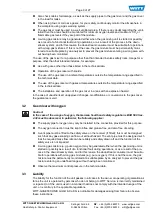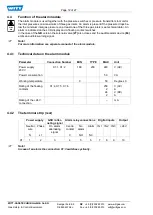
Page 8 of 27
WITT-GASETECHNIK GmbH & Co KG
Salinger Feld 4-8
: +49 (0)2302 89010
www.wittgas.com
Gas Safety- & Control Equipment
D-58454 Witten
Fax: +49 (0)2302 89013
3
Safety instructions and precautionary measures
It is imperative that the following safety instructions and precautionary measures are observed and
followed. They are intended to avoid hazards that can arise during the use of the system.
In addition, the applicable national health and safety regulations and safety regulations from the
trade associations are to be observed. For example, in Germany:
Health and safety regulations from the trade associations
a) DGUV Regulation 1 Grundsätze der Prävention (principles of prevention)
b) DGUV Regulation 3 Elektrische Anlagen und Betriebsmittel
(Electrical Systems and Equipment)
c) BGR 500 Sec. 2.33 Gase (Gases)
d) BGR 500 Sec. 2.32 Sauerstoff (Oxygen) - if used as a supply gas
The Pressure Devices Regulations and appropriate technical regulations
a) TRB 600
Aufstellung der Druckbehältern (Installation of Pressurised Vessels)
b) TRB 404
Ausrüstung der Druckbehälter, Ausrüstungsteile
Equipment for Pressurised Vessels, Equipment Parts)
c) TRB 700
Betrieb von Druckbehältern (Operating Pressurised Vessels)
must be observed.
No claim is made that this list is absolute.
Along with the instruction manual and the health and safety regulations applicable in the country
and place of use, recognised engineering regulations for safe and correct working are to be ob-
served.
The operating organisation must ensure that only authorised persons work on or with the system.
The gas mixer is built to the state of the art and is safe to operate. Hazards can be produced by the
gas mixer if it is used incorrectly by untrained personnel, or is not used for the purpose intended.
3.1
General safety instructions
Caution!
Only persons who have been instructed on the operation of the system and who have read
and understood this manual are permitted to use the system.
Observe national technical regulations on the handling of gases, e.g. applicable health and
safety regulations.
Any unauthorised modifications or changes to the system are forbidden for safety reasons.
Malfunctions arising during operation may only be rectified by trained personnel.
Maintenance- and repair tasks may only be performed by trained personnel.
During all maintenance- and repair tasks ensure that the gas mixer is isolated from mains elec-
tricity (also observe external voltage, e.g. via floating contacts) and is de-pressurised.
All supply pipes to and from the gas mixer are to be designed for the maximum permitted gas
pressure. If this is not possible for the system following the gas mixer, then it must be ensured
that the maximum permitted pressure for the following system cannot be exceeded by means
of the installation of suitable fittings, e.g., bursting discs or safety valves.
The material for the gas pipes (pipes from the gas supply to the inlets on the gas mixer), all fit-
tings installed there (e.g. shut-off valves, gauges, etc.) and all sealing elements there must be
designed for the related type of gas.
The material for the gas outlet pipe (pipe from the outlet on the gas mixer to the load), all fit-
tings installed there (e.g. shut-off valves, gauges, etc.) and all sealing elements there must be
designed for all the related types of gas.
The maximum gas inlet pressures in the technical data must not be exceeded. If necessary
this is to be ensured by the installation of safety valves or bursting discs.
Check the connections and joints for leaks to atmosphere at regular intervals (e.g. at every
commissioning) with inert gas and document this check. For this purpose only use suitable
leak detection methods. Never check using a naked flame! If you find leaks, rectify them im-
mediately; the applicable safety regulations are to be observed during this process.









































